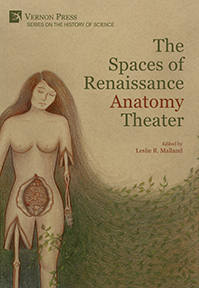
Editor: Leslie R. Malland (University of Texas Permian Basin)
Publisher: Vernon Press, 2022
The space of Renaissance anatomy is not solely in the physical theatre. As this collection demonstrates, the space of the theatre encompasses every aspect of Renaissance culture, from its education systems, art, and writing to its concepts of identity, citizenship, and the natural world. This book argues that Renaissance anatomy theatres were spaces of intersection that influenced every aspect of their culture, and that scholars should broaden their concept of anatomy theatres to include more than the physical space of the theatre itself. Instead, we should approach the anatomy theatres as spaces where cultural expression is influenced by the hands-on study of human cadavers.
Contents
List of Figures and Tables
Acknowledgements
About the Authors
Introduction: Defining the Spaces of Renaissance Anatomy Theater
Let His Body be Unburi’d: The Tabulae Evelinianae and the Allegory of the Anatomized Body in Early Modern England – Giulia Mari
The Anatomy Theater in Renaissance Italy: A Space of Justice? – David Soulier
The Teaching of Anatomy at the University in the South of Europe: The Case Study of the Universities of Coimbra and Salamanca (XIV-XVI) – Carlos Fernando Teixeira Alves
“How sweetly then she on her death-bed lay”: Edward May’s Rhetorical Anatomization of a Woman Burned at the Stake – Jennifer Lodine-Chaffey
Her Body, His Evidence: Female Subjugation in the Early Modern Anatomy Theaters – Leslie R. Malland
“Into the Bowels of Ungrateful Rome”: Anatomizing the Body-Politic of Shakespeare’s Coriolanus – Gilad Gutman
“Nous ne scavons distinguer la peau de la chemise”: Perceiving the Naked Skin in Montaigne’s Essais and Titian’s Flaying of Marsyas – Elizabeth Anne Kirby
“Et corps qu’est-ce?”: Dismantling Body in Montaigne’s Essais and Estienne’s La dissection des parties du corps humain en trois livres – Elizabeth Anne Kirby
Gardens in the Anatomy Theater: Recreating the Garden of Eden in Leiden’s Anatomy Theater – Kaleigh Hunter
Conclusion: Expanding the Spaces of Renaissance Anatomy Theater – Leslie R. Malland
Bibliography
Works Consulted
Consulted Collections
Annexes
Index